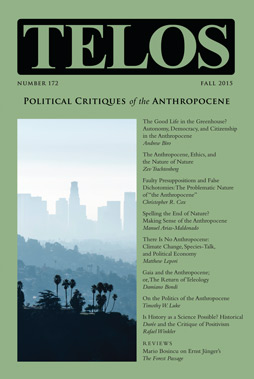Damiano Bondi’s “Gaia and the Anthropocene; or, The Return of Teleology” appears in Telos 172 (Fall 2015). Read the full version at the Telos Online website, or purchase a print copy of the issue in our store.
 The Gaia hypothesis was formulated for the first time in 1979 by James Lovelock. According to this conception, the Earth should be seen as a macro-organism whose purpose is to keep constant some conditions that are necessary for the presence of life on its surface. However—often with the consent of Lovelock himself—this scientific hypothesis has gone beyond its limits, transforming itself in a sort of anti-humanistic pseudo-religion: the Earth becomes a kind of divinity (Gaia) with a purposive will. This process of “personification” is quite paradoxical: Nature acquires features that are denied, at the same time, to the single man. In fact the human being, in this conceptual framework, is only a part of the Great Whole, the Mother Nature; he cannot be “her” guardian at all, he has to abandon any pretense of ontological superiority and to “believe” in the infinite potential of Gaia, who always finds a way to restore the threatened balance. On the ontological level, there is no difference between the single man and the natural ambient that surrounds him; so, on the moral level, this metaphysical conception ends to justify the indifference of the person to the impact of his own actions on the ecosystem. Not surprisingly, Lovelock has recently been deployed in favor of nuclear power.
The Gaia hypothesis was formulated for the first time in 1979 by James Lovelock. According to this conception, the Earth should be seen as a macro-organism whose purpose is to keep constant some conditions that are necessary for the presence of life on its surface. However—often with the consent of Lovelock himself—this scientific hypothesis has gone beyond its limits, transforming itself in a sort of anti-humanistic pseudo-religion: the Earth becomes a kind of divinity (Gaia) with a purposive will. This process of “personification” is quite paradoxical: Nature acquires features that are denied, at the same time, to the single man. In fact the human being, in this conceptual framework, is only a part of the Great Whole, the Mother Nature; he cannot be “her” guardian at all, he has to abandon any pretense of ontological superiority and to “believe” in the infinite potential of Gaia, who always finds a way to restore the threatened balance. On the ontological level, there is no difference between the single man and the natural ambient that surrounds him; so, on the moral level, this metaphysical conception ends to justify the indifference of the person to the impact of his own actions on the ecosystem. Not surprisingly, Lovelock has recently been deployed in favor of nuclear power.




The problem with teleology is the general failure to distinguish between the observed directionality of our universe and the quite separate (and illusory) anthropocentrically derived notion of “purpose”.
Among those who claim to speak for science there are many have fallen foul of the widely promulgated idealogical doctrine that “there is no directionality in evolution”. A rhetoric which is entirely contrary to our observations! For, while the inputs to evolutionary processes are indeed largely random, directionality is imparted by ratcheting mechanisms inherent in nature’s machinery. In the case of biology, mutation is an example of random input. But natural selection is the primary ratcheting mechanism. A rectifier which provides direction.
Goal-seeking is a rather different matter from directionality, as is predictability, although these concepts are, of course, in some ways inter-related.
We can quite reasonably ascribe short-term goals to some natural processes.
Self replication is an example. But in doing so we have to be careful not to fall into another very common trap. That of anthropomorphism. Of implying an agency of the kind that we perceive (only partly illusory) in our own mental processes. The human-centred view-point which, in the past, has led to our species generating a variety of deities and in recent times the equally spurious and nonsensical notion of “intelligent design”
Directionality is most clearly observable in the whole evolutionary network. A continuum which can be traced from the formation of chemical elements in the stars right through the the evolution of technology in the medium of shared human imagination. While we have no basis to ascribe any “goal” to the process (other than, perhaps, to “keep on keeping on”), its short term future is even grossly predictable.
This and related subjects are expanded upon in my latest book “The Intricacy Generator: Pushing Chemistry and Geometry Uphill”. Now available as 336 page illustrated paperback from Amazon, etc.